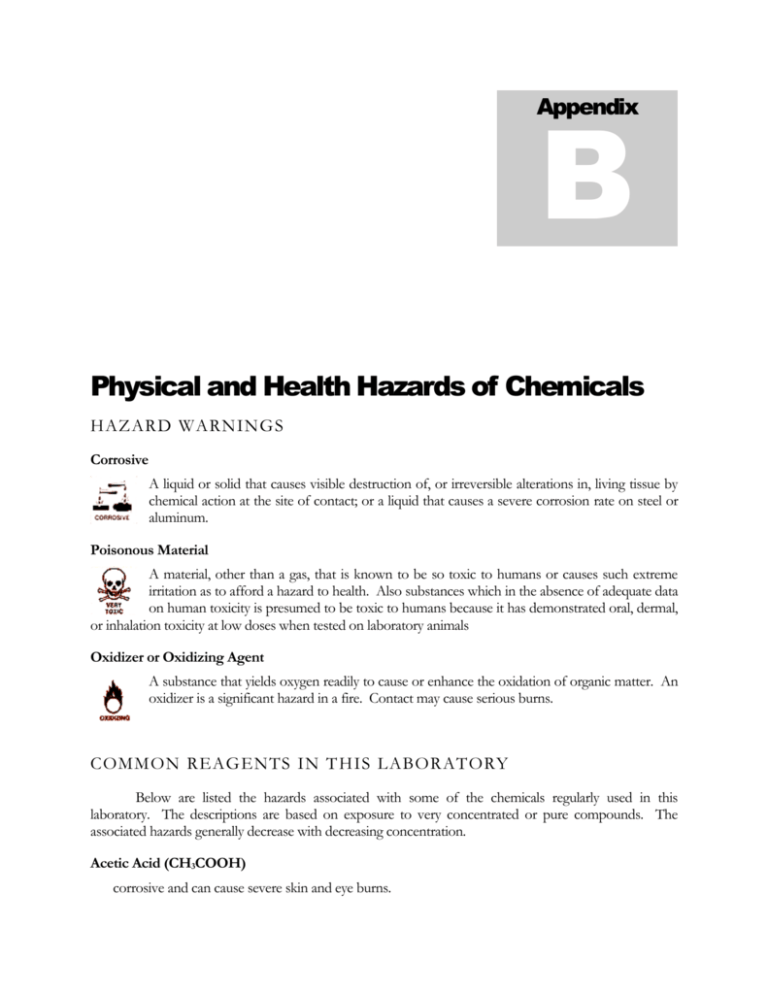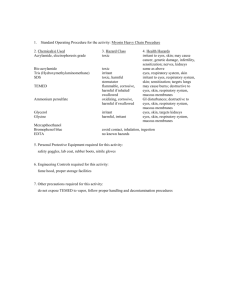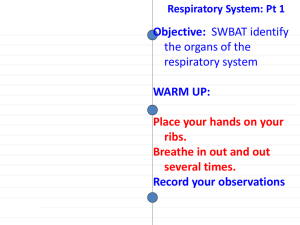Physical And Health Hazards Of Chemicals
advertisement

B Appendix Physical and Health Hazards of Chemicals HAZARD WARNINGS Corrosive A liquid or solid that causes visible destruction of, or irreversible alterations in, living tissue by chemical action at the site of contact; or a liquid that causes a severe corrosion rate on steel or aluminum. Poisonous Material A material, other than a gas, that is known to be so toxic to humans or causes such extreme irritation as to afford a hazard to health. Also substances which in the absence of adequate data on human toxicity is presumed to be toxic to humans because it has demonstrated oral, dermal, or inhalation toxicity at low doses when tested on laboratory animals Oxidizer or Oxidizing Agent A substance that yields oxygen readily to cause or enhance the oxidation of organic matter. An oxidizer is a significant hazard in a fire. Contact may cause serious burns. COMMON REAGENTS IN T HIS LABORATORY Below are listed the hazards associated with some of the chemicals regularly used in this laboratory. The descriptions are based on exposure to very concentrated or pure compounds. The associated hazards generally decrease with decreasing concentration. Acetic Acid (CH3COOH) corrosive and can cause severe skin and eye burns. Acetone (CH3CO CH3) prolonged or repeated skin contact causes irritation and mild dermatitis. Inhalation of the fumes may produce unconsciousness. It is extremely flammable. Activated Carbon (charcoal) inhalation of excessive dust causes respiratory irritation Ammonia, aqueous (NH3)aq the liquid and vapor is immediately and extremely irritating and corrosive to the eyes, skin, and respiratory tract Ammonium Chloride (NH4Cl) a mild irritant to the eyes, skin, and respiratory tract. Ammonium Metavanadate (NH4VO3) corrosive and can cause burns on skin and eyes. It is also an oxidizing agent and can cause severe eye, skin and respiratory tract irritation or burns. Barium Nitrate (Ba(NO3)2) an oxidizer and irritant to the eyes, skin, and respiratory tract. Toxic by ingestion. If ingested it may cause tightness of the muscles of the face and neck, vomiting, diarrhea, abdominal pain, muscular tremors, anxiety, weakness, labored breathing, cardiac irregularity, convulsions, and death from cardiac and respiratory failure. Estimated lethal dose lies between 1 to 15 grams. Boric Acid (H3BO3) an irritant to the eyes and skin Bromocresol Green a mild irritant to the eyes, skin, and respiratory tract. Will cause intensely colored stains on skin and clothing. Chromium Nitrate (Cr(NO3)3) a strong irritant to the skin, eyes, and respiratory tract. Prolonged contact may result in ulceration at point of contact. Cobalt Sulfate (CoSO4) dust causes respiratory, skin and eye irritation. May cause allergic skin reaction after prolonged contact. Cobalt Chloride (CoCl2) dust causes respiratory irritation. May cause allergic skin reaction after prolonged contact. Copper Nitrate (Cu(NO3)2) a strong irritant to the skin, eyes, and respiratory tract. Prolonged contact may result in ulceration at point of contact. Ethanol, Ethyl Alcohol (CH3CH2OH) an eye and mucous membrane irritant and central nervous system depressant in both liquid and vapor form. It is very flammable. Hydrochloric Acid (HCl) a fuming liquid with a sharp, pungent, irritating odor of hydrogen chloride gas. It is a corrosive irritant to the skin, eyes, and mucous membranes. The corrosive action of hydrochloric acid on most metals liberates hydrogen gas. Hydrogen Peroxide (H2O2) considered corrosive at concentrations above 8%. It is a strong oxidizer and can cause severe eye, skin, and respiratory tract irritation and burns. Iron Nitrate (Fe(NO3)3) a strong irritant to the skin, eyes, and respiratory tract. Prolonged contact may cause a brownish discoloration to the eye. Lead Nitrate (Pb(NO3)2) Poison! Contact over short periods may cause local irritation, redness and pain. Lead nitrate may be absorbed through the eyes or skin on prolonged exposure; the symptoms of lead poisoning include abdominal pain and spasms, nausea, vomiting, headache. Acute poisoning can lead to muscle weakness, "lead line" on the gums, metallic taste, definite loss of appetite, insomnia, and dizziness. Nitric Acid (HNO3) a strong oxidizer that can ignite combustible materials. It is very corrosive to human tissue and can produce severe burns of the eyes, skin, and respiratory tract. Phenolphthalein an irritant to the eyes, skin, and respiratory tract. Potassium Hydrogen Phosphate (K2HPO4) a mild irritant to the eyes, skin, and respiratory tract. Potassium Permanganate (KMnO4) a strong oxidizer that is incompatible with many materials. Concentrated solutions are highly corrosive to human tissue. Potassium Phosphate (K3PO4) a moderately corrosive irritant. Contact with the eyes or skin produces symptoms including redness, itching, and pain. Silver Nitrate (AgNO3) causes severe irritation to the eyes, skin, and respiratory tract. Prolonged or repeated exposure of silver compounds may cause argyria, a permanent bluish discoloration of the skin, eyes, and mucous membranes. Sodium Acetate (CH3COONa) a mild irritant to the eyes, skin, and respiratory tract Sodium Hydroxide (NaOH) generates large amounts of heat when mixed with water or acids. It is a strong and corrosive alkali that dissolves human tissue and can cause permanent injury. Sodium Nitrate (NaNO3) a strong oxidizing agent. It is mildly irritating to the eyes, skin, and respiratory tract. Sodium Sulfite (Na2SO3) a mild irritant to the eyes, skin and respiratory tract Sulfur Dioxide (SO2) a colorless gas with a sharp, pungent odor. It forms corrosive sulfuric acid on contact with mucous membranes or moist skin. The lungs can be severely damaged by inhalation. Can trigger asthmatic attacks. Sulfuric Acid (H2SO4) the concentrated acid reacts violently when mixed with water, generating large amounts of heat. Extremely corrosive to body tissue resulting in severe burns and possible permanent damage. Thymolphthalein a mild irritant to the eyes, skin, and respiratory tract. Will cause intensely colored stains on skin and clothing Zinc harmful to the eyes and respiratory tract. It forms flammable and irritating fumes upon contact with acids.









